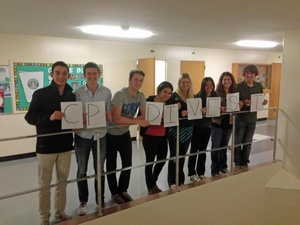This page documents the partnership of SUSTAIN students Phillip Hatcher, Kristen Limos, Sam Canino, Jose Parra, Harry Chaw and Colten Byers with Cal Poly Divest Fossil Fuels. Our project involved taking on the goals of the campaign of divesting Cal Poly from fossil fuels, developing the campaign further, in addition to learning about campaign development and management. The campaign to divest Cal Poly from fossil fuels is one chapter of the "Go Fossil Free" (gofossilfree.org) campaign led by 350.org. The mission of the campaign is to pass a resolution for Cal Poly to freeze further investments in the fossil fuel industry and to disinvest from the top 200 traded fossil fuel companies within 5 years. The main webpage for this campaign is at cpdivest.com. This page focuses on the project from a project management perspective, providing certain management tools with reflections by Sam Canino and Phillip Hatcher, the two project managers.
 From left to right: Jose Parra, Phillip Hatcher, Sam Canino, Ingrid Gutierrez, Megan Baur, Kristen Limos, Kylie Hensley, and Jeremy Black
From left to right: Jose Parra, Phillip Hatcher, Sam Canino, Ingrid Gutierrez, Megan Baur, Kristen Limos, Kylie Hensley, and Jeremy Black
Defining the project with the project charter:
Phillip's reflection:
"I felt that the project charter was very valuable; it was able to take this very broad project, and define specifics. I felt it was also valuable to define the scope of this project. This is one campaign, that's part of a nationwide campaign, that's part of a global movement, so this project could very easily give way to scope creep. Doing this project charter, and really sitting down and committing and outlining this project, took what I was going to be working on for the next two quarters and let it really sink in. I got really excited while I was working on this charter because I felt that by working with this campaign I could make a real difference not just in this community, but on a national scale. To be working for a larger cause is something I'm very proud of."
Sam's reflection:
"
Promoting safety with a safety poster:
Accounting for possible risks with a risk and contingency analysis:
Risk Analysis Chart
Phillip's reflection:
"At first I felt that the risk analysis didn't apply very well to our particular project, because our "project site" could be summed up by meetings and car rides. Then as I kept thinking, making the giant 7'x12' trifold and displaying that, in addition to driving, are both project sites that have potential dangers associated with them. Something simple that hadn't crossed my mind was the fact that our giant trifold is just plywood, and therefore it's probably very flammable. Keeping this display away from open flame is something we need to by very conscious of. Overall, the risk analysis was a great way to sit down and consider possible dangers that normally would have gone unaccounted for."
Sam's reflection:
"
Mapping out project tasks with a work breakdown structure:
Phillip's reflection:
"When we first started this project, it was ill defined what we were really doing. We knew that things needed to be done, and people would do them whenever they got the chance but it felt largely unorganized and chaotic. Then one meeting someone suggested that we break the tasks into certain areas of the campaign. We then appointed "subcommittee heads" that were in charge of managing each subcommittee area. Anyone could work on anything from whatever subcommittee they felt like working with, but these subcommittee heads were to be held accountable for their area of the campaign. After we established the subcommittees we delegated certain tasks to them. All in all, we essentially made a work breakdown structure on our own, so creating this document was just a matter of writing it down. Ultimately the campaign is now much more organized and focused. The direction we're taking for this campaign has changed a couple times though, and the group has further developed and adapted to account for these changes, so this work breakdown structure may need updating as we continue to move forward."
Sam's reflection:
"
Tackling specific tasks with a Gantt Chart:


